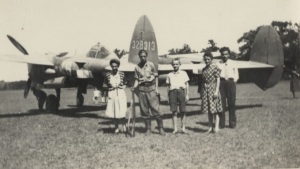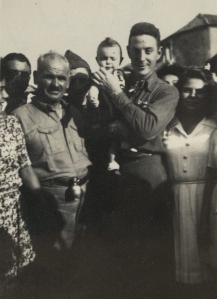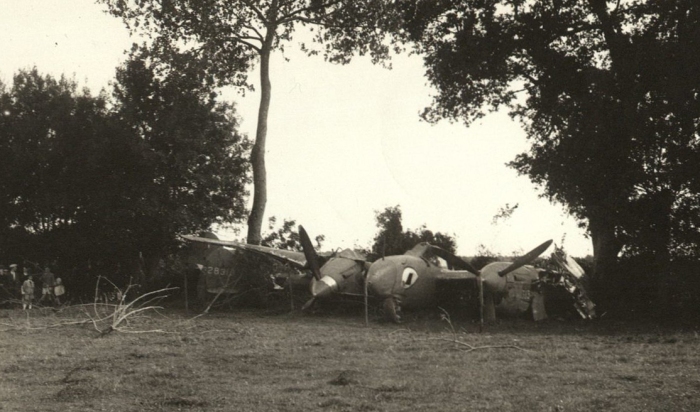By Mike Hankins
One of the lesser known large contributors to Allied victory in World War II was the role of aerial photographic reconnaissance. The allies relied on up-to-date photographs from the air. Flying these photo ‘recce’ missions could be every bit as harrowing as combat sorties. Recce planes flew over enemy territory with their guns removed and replaced with cameras. If they were attacked, pilots had no choice but to try and escape using only speed and manoeuvring, hoping to hide inside cloud cover or just to outrun the enemy. Up until the D-Day invasion, many of these missions were flown at extremely high speed and low altitude, as low as five to fifteen feet over the beaches of Normandy. Pilots likened these missions to throwing dice across a gambling table and called them ‘dicing’ missions. To get an in-the-cockpit view of what flying recce missions could be like, I am going to outline a brief period in the career of First Lieutenant George Adams, Jr., who joined the 30th Photographic Reconnaissance Squadron (PRS) in Toussus le Noble, France at the end of July 1944.
Adams flew the F-5, which was a Lockheed P-38 Lightning modified to take photos. The P-38 was not an uncontroversial plane, drawing mixed reviews from those that flew it. Ace fighter pilot Captain Jack Ilffey called it ‘a beautiful monster.’[1] Famed pilot Brigadier General Robin Olds, later noted for his contributions to air combat in the Vietnam War, first earned ace status in a P-38 in World War II. As he recalled,
I loved the P-38 but I got those kills in spite of the airplane, not because of it. […] The P-38 Lightning was too much airplane for a new kid and a full-time job for even a mature and experienced fighter pilot. Our enemies had difficulty defeating the P-38 but, as much as we gloried in it, we were defeating ourselves with this airplane.[2]
Although, from an air combat perspective, the P-38 was not nearly as effective as other fighter types, such as the North American P-51 Mustang, the Lightning’s high speed, long range, and sheer toughness allowed it to excel in the role of photo reconnaissance. Allied forces had learned early on that a group of F-5s together was easily spotted, so to reduce the likelihood of being seen, photo reconnaissance missions were often flown by single planes, unescorted and completely alone, usually deep over enemy territory.

Adams happened to arrive at a time when the 30th PRS was busier than it ever had been. The official unit history referred to August of 1944 as the ‘month of months.’ Ten August 1944 saw more missions take to the air than on D-Day itself. [3] For Adams, however, that month witnessed one of the defining moments of his career and very nearly cost him his life.

On 3 September, Adams was flying a reconnaissance mission over Belgium, when the weather took a turn for the worse. Due to extremely limited visibility, Adams flew far off course. With his fuel tanks almost empty, he had no choice but to land in the town of Mussidan in southwestern France. Luckily, just over one week previously on 25 August, the town had been liberated by the French Forces of the Interior (FFI). The townspeople welcomed him as a hero and gave him a place to stay at a nearby hotel for three days. The French resistance was able to purchase some German gasoline, and at the first sign of clear weather, on 6 September, Adams took off. After signalling his thanks by flying a few victory laps around the town, he headed back to Toussus le Noble.[4]
Adams’ ordeal was not over. The weather, which the 30th PRS unit historian called, ‘the airman’s most relentless foe,’ again proved troublesome for Adams on his flight back to base. After becoming lost in rough weather and losing all radio contact with his commanding officer, Major William Mitchell (not to be confused with the other Billy Mitchell, author of Winged Defense), Adams attempted to land in a field near Morannes and slammed his P-38 into a grove of trees. Adams himself was unharmed, but the aircraft was disabled. There was a military group at Morannes, and Adams stayed with them before travelling to an airstrip at Le Mans, about thirty miles away. Cooperating with intelligence services at Le Mans and the FFI, Adams tried to contact Major Mitchell but was unable to do so. The officials at Le Mans eventually brought Adams to Versailles on 8 September, where he was able to reconnect with the 30th PRS, and he returned to flying duty the next day.[5]

Typically, the weather of the winter months limits photo recce missions. However, that was the least of the allies’ problems in December of 1944 as eight panzer divisions tore their way through the Ardennes forest, beginning what became known as the Battle of the Bulge. The 30th PRS joined the battle, providing valuable photographs to aid ground units. However, the weather again reared its head. Only five days before the end of the year were suitable for taking photos. The 30th managed to squeeze out 96 missions in those five days. Adams and his fellow pilots flew as much as possible, including flying multiple missions on Christmas Eve, Christmas day, and New Year’s Eve. The squadron set a record for a number of photographs processed: nine miles of film, consisting of 44,306 negatives that produced 153,579 prints.[6]
On New Year’s Day, 1945, ground forces requested an urgent, secretive mission to be flown over a particularly well-defended area of the German lines during the Battle of the Bulge. The nature of the photographs needed required a low-altitude approach of 2,000 feet, rendering the reconnaissance planes especially vulnerable to ground defences. Adams and six other pilots volunteered for the job. Four of them, including Adams, flew out twice. Despite the heavy risk and the intrusion of adverse weather conditions, the mission was a success, providing valuable intelligence to the front lines. The secretive nature of the mission prevented much discussion of it at the time, however, several months later, on 21 July 1945, Adams was awarded the Distinguished Flying Cross for flying his ‘unarmed photographic aircraft under circumstances entailing utmost courage and skill.’[7]
In the popular memory of World War II, we often tend to celebrate or romanticise the fighter pilots or bomber crews that engaged in seemingly heroic combat actions. However, Adams and his fellow recon pilots should not be forgotten. They took serious risks and made key contributions to the Allied victory in World War II.
Mike Hankins is a doctoral candidate at Kansas State University, where he teaches World History, the History of Airpower, and the History of Comic Books, and he is currently working on his dissertation, ‘Sources of Innovation: The Cultural and Technological Origins of Fourth Generation Fighter Aircraft, 1964-1991.’ He completed his master’s thesis at the University of North Texas in 2013, titled ‘The Phantom Menace: The F-4 in Air-to-Air Combat in the Vietnam War. He has a web page and can be found on Twitter at @hankinstien.
Header Image: Ground personnel of the 7th Photographic Reconnaissance Group fit cameras into a Lockheed F-5 Lightning before a long-range mission. Image by Staff Sergeant Robert Astrella, 7th Photographic Reconnaissance Group. (Source: ©IWM (FRE 5390))
[1] Robert F. Dorr, ‘Why the P-38 Flunked in Europe,’ Aviation History 24 (May 2014), 22.
[2] Ibid.
[3] US Air Force Historical Research Agency (AFHRA), Maxwell AFB, 30th Photo Reconnaissance Squadron Unit History for the Month of August, 1944; Morse Special Collections, Kansas State University, Personal Papers of George Adams, Box 3, George Adams Pilot Information File, August 1944. Hereafter, the Adams Papers.
[4] AFHRA, 30th Photo Reconnaissance Squadron Unit History for the Month of September, 1944; Testimony of Labattu de Montpon, as related in email from Mayor Stephane Triquart to Bruce Adams, 21 January 2016.
[5] AFHRA, 30th Photo Reconnaissance Squadron Unit History for the Month of September, 1944.
[6] Ibid.
[7] AFHRA, Recflash, Vol. 2 No. 1, Highlight Missions, 2, attached to Historical Records and History of Headquarters 67th Tactical Reconnaissance Group, Month of January 1945; Morse Special Collections, Kansas State University, Adams Papers, Box 3, Quote from Distinguished Flying Cross award citation, General Orders 116, 27 June 1945.
You might find this book of interest: https://www.amazon.com/Tiger-Joe-Photographic-Aerial-Reconnaissance/dp/0975871471/. Mr. Thompson was still alive when it came out. At the book launch in 2006, he told hair-raising stories of his P-51 exploits.
LikeLike